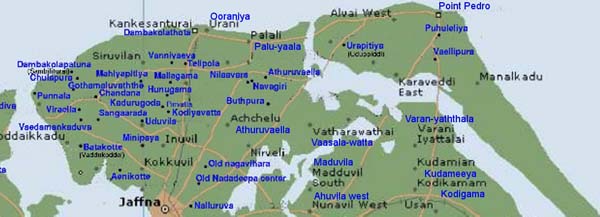A roadway crammed with history: Jaapanaya (Jaffna)-Athuruvaella (Atchuvel)-Vakthuduva (Point Pedro)
Posted on July 12th, 2011
Chandre Dharmawardana
A new item carried in severalƒÆ’-¡ƒ”š‚ newspapers (12-July-2011) says that the “Jaffna-Atchuveli-Point Pedro route was re-opened to the public yesterday after 28 years. It was closed for general traffic from 1983 after terrorists destroyed the Thondaman Aru bridge.”
The Thondaman referred to in “Thondaman-aru” was Karunagaran Thondaman, a Chola minister who explored the possibility of exporting salt from North Sri Lanka to the Chola Kingdom.
Most people are aware that the name “Jaa-panaya” originally signified the Javanese village that came into being after ChandrabhanuƒÆ’-¡ƒ”š‚ a Javanese ruler from Tambralinga invaded Sri Lanka in the 13th Century CE. His armies landed in Gokanna (Trincomalee), and used blow pipes and poisoned arrows against localƒÆ’-¡ƒ”š‚ armies.ƒÆ’-¡ƒ”š‚ He ruled the peninsula for three decades.
However, not many seem to be aware that Atchuveli, or Athuruvaella in Sinhalese had been important enough to be mentioned byƒÆ’-¡ƒ”š‚ de Queyroz, the Portuguese historian.ƒÆ’-¡ƒ”š‚ De QueyrozƒÆ’-¡ƒ”š‚ says that Philippo d’Olivero wrested the town from the SinhaleseƒÆ’-¡ƒ”š‚ King when he “defeated the Cingalezen forces nearƒÆ’-¡ƒ”š‚ the great pagoda” in Athuruvaella.
The road through Athuruvaella to Point Pedro (Vak Thudaava) passes through ancient Buddhist villages. Thus Gothamaluvaththa (Kaddupulan)ƒÆ’-¡ƒ”š‚ is less than a kilometer from Punnala (Ponnalai). Here excavations revealed a pre-Christian temple complex. Many other ancient Buddhist sites are within bicycling distance from here. Puththur, or Buthpura is another ancient site whose antecedents are now forgotten. Navagiri (Navakkiri),ƒÆ’-¡ƒ”š‚ Nilavara (Nilavarai), Urapitiya (Uddupiddi), Puhuleliya (Puloli), and Vaelipura (Allipuram) are other old towns not far from this route.
Vaelipura is well known for a 1st century gold plate ascribed to King Vasabha. The ancient Prakrit place-name “Bandakara -Aethana” of that era is well recognized by scholars.
Nilavara (Nilavarai) is also a famous site. Prof. Karthigesu Indraratne writesƒÆ’-¡ƒ”š‚ ” A lime-stone Buddha image and the remains of an ancient dagaba wereƒÆ’-¡ƒ”š‚ unearthed at Nilavarai, in Navakkiri. Among the debris were two sculptured fragments of shaped coral stones with a stone railing design. According to D.T. Devendra, who conducted the excavation at this site, the dagaba can be dated at least to the tenth century A.D. Near these ruins are the foundations of an ancient building and in the middle of these is a modern Siva temple. It has been conjectured, and rightly so, that the old foundations are those of the vihara attached to the ancient dagaba”.
Point Pedro itselfƒÆ’-¡ƒ”š‚ is a name introduced by Portuguese mariners. Older names “Kapu Thuduva”, “Kava thuduva” and “Vak-thuduva which mutated to Vaththuduva” also may have existed. “Vartha”, “Vak”, “kava” etc., mean circular, and may have referred to the shape of the coastline here, when the easterly extension of the shore ends and the shore line curves abruptly southwards. In Pali, “Vartha” becomes “Vatta”, and in sinhala it changes to “Vaka” or “Vata”. A recognizedƒÆ’-¡ƒ”š‚ transpositon of phonetic elements may change “Vaka” to “Kava”. In Tamil, the nameƒÆ’-¡ƒ”š‚ ParithithuraiƒÆ’-¡ƒ”š‚ has been used. Here again, Parithi may have come from “Vartha”, the Sanskrit word, and absorbed into Tamil as wellƒÆ’-¡ƒ”š‚ as Sinhalese.
Given this unusual tapestry of ancient Pali-PrakritƒÆ’-¡ƒ”š‚ names, subsequent Sinhalese place names, and their more modern Tamilizations, it is unfortunate that this richƒÆ’-¡ƒ”š‚ cultural potential is not exploited to the fullest. Such exposure is in the interests of tourism as well as for restoring the imbalance in historical information.ƒÆ’-¡ƒ”š‚ We are not advocating the suppression of any local names what so ever. Instead,ƒÆ’-¡ƒ”š‚ we strongly urge that the older and newerƒÆ’-¡ƒ”š‚ names as well as the history of these ancient placesƒÆ’-¡ƒ”š‚ be resurrected and brought to the forefront.
It is customary for ancient cities to be known by several names, as we know from Alexandria or Constantinople, andƒÆ’-¡ƒ”š‚ Achen or Aix-en-Chapplle.
A map of the relevant region of the Jaffna peninsula may be found at
http://dh-web.org/place.names/maps/Jaffna-Pt.Pedro.jpg.
Similarly, a discussion of these place names may be found in http://dh-web.org/place.names/index.html .

July 12th, 2011 at 7:36 pm
Good work CD.
The dh website is a blessing for all SLs. Please continue with your good work.
All ancient sites in the north must be reinstated. Old names must be used along with new names.
July 12th, 2011 at 9:42 pm
This map shows how many Buddhist sites are found in Jaapanaya (Yapapatuna). Many people think it is only
the Naga Vihara that is there.